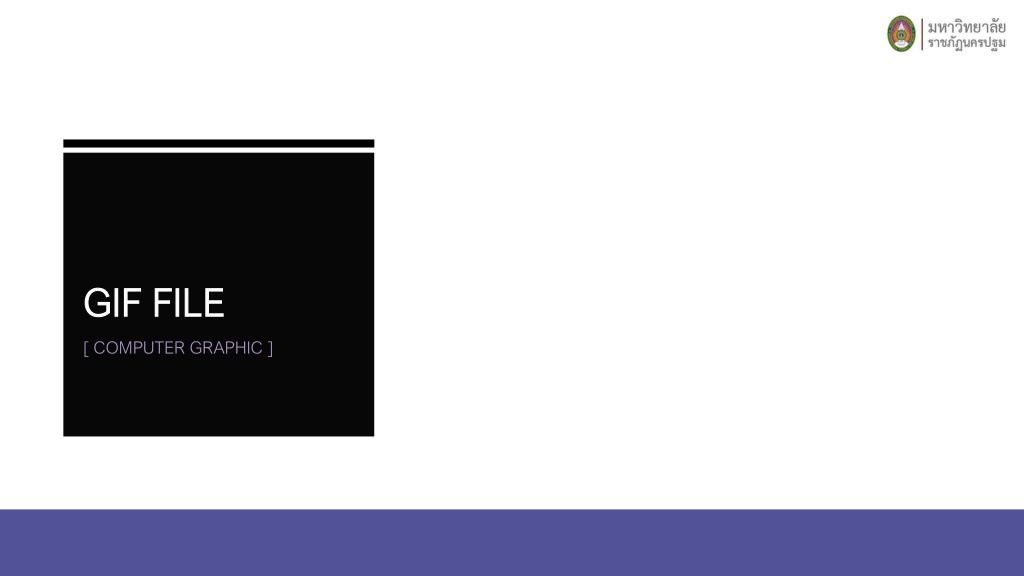
Learn about the History and Features of GIF Images
Discover the origins, development, and key features of GIF images introduced by CompuServe in 1987. Explore how GIFs support up to 256 colors, animations, and compression techniques for efficient file sizes without compromising visual quality. Dive into the differences between the 87a and 89a versions and the impact of GIF on the digital landscape, including its widespread use on the World Wide Web.
Uploaded on | 0 Views
Download Presentation

Please find below an Image/Link to download the presentation.
The content on the website is provided AS IS for your information and personal use only. It may not be sold, licensed, or shared on other websites without obtaining consent from the author. Download presentation by click this link. If you encounter any issues during the download, it is possible that the publisher has removed the file from their server.
E N D
Presentation Transcript
GIF FILE GIF FILE [ COMPUTER GRAPHIC ]
GIF FILE GIF FILE The Graphics Interchange Format (GIF) is a bitmap image format that was developed by a team at the online services provider CompuServe led by American computer scientist Steve Wilhite on June 15, 1987.[1] It has since come into widespread usage on the World Wide Web due to its wide support and portability between many applications and operating systems.
GIF FILE GIF FILE The format supports up to 8 bits per pixel for each image, allowing a single image to reference its own palette of up to 256 different colors chosen from the 24-bit RGB color space. It also supports animations and allows a separate palette of up to 256 colors for each frame. These palette limitations make GIF less suitable for reproducing color photographs and other images with color gradients, but it is well-suited for simpler images such as graphics or logos with solid areas of color.
GIF FILE GIF FILE GIF images are compressed using the Lempel Ziv Welch (LZW) lossless data compression technique to reduce the file size without degrading the visual quality. This compression technique was patented in 1985. Controversy over the licensing agreement between the software patent holder, Unisys, and CompuServe in 1994 spurred the development of the Portable Network Graphics (PNG) standard. By 2004 all the relevant patents had expired.
HISTORY HISTORY CompuServe introduced GIF on June 15, 1987 to provide a color image format for their file downloading areas, replacing their earlier run-length encoding (RLE) format, which was black and white only. GIF became popular because it used LZW data compression, which was more efficient than the run-length encoding that formats such as those used by PCX and MacPaint, and fairly large images could therefore be downloaded in a reasonably short time, even with very slow modems.
HISTORY HISTORY The original version of GIF was called 87a. In 1989, CompuServe released an enhanced version, called 89a, which added support for animation delays (multiple images in a stream were already supported in 87a), transparent background colors, and storage of application-specific metadata. The 89a specification also supports incorporating text labels as text (not embedding them in the graphical data), but as there is little control over display fonts, this feature is not widely used. The two versions can be distinguished by looking at the first six bytes of the file (the "magic number" or signature), which, when interpreted as ASCII, read "GIF87a" and "GIF89a", respectively.
HISTORY HISTORY CompuServe encouraged the adoption of GIF by providing downloadable conversion utilities for many computers. By December 1987, for example, an Apple IIGS user could view pictures created on an Atari ST or Commodore 64. GIF was one of the first two image formats commonly used on Web sites, the other being the black-and-white XBM.
HISTORY HISTORY In September 1995 Netscape Navigator 2.0 added the ability for animated GIFs to loop. The feature of storing multiple images in one file, accompanied by control data, is used extensively on the Web to produce simple animations. The optional interlacing feature, which stores image scan lines out of order in such a fashion that even a partially downloaded image was somewhat recognizable, also helped GIF's popularity, as a user could abort the download if it was not what was required. In May 2015 Facebook added support for GIF. In January 2018 Instagram also added GIF stickers to the story mode.
